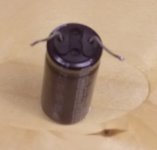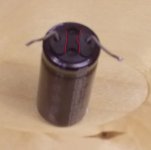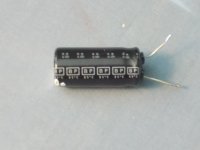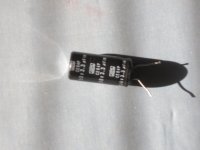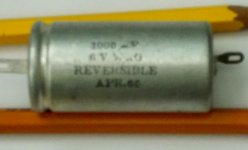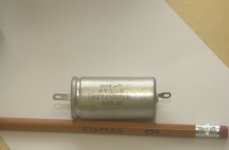I've gotten spoiled by using electrolytics with a nice big stripe down the side, marked with a (-) sign and arrows pointing to the negative lead.
I came across a Nippon Chem cap today which only had a very subtle mark on the base. See pics- my apologies for the blurry quality.
I was able to figure out which lead was attached to the PCB ground plane, so wasn't puzzled for long, but I guess this little bump in the base molding was the clue to (-) polarity?
I came across a Nippon Chem cap today which only had a very subtle mark on the base. See pics- my apologies for the blurry quality.
I was able to figure out which lead was attached to the PCB ground plane, so wasn't puzzled for long, but I guess this little bump in the base molding was the clue to (-) polarity?
Attachments
Does it say BP down the side by any chance?
Yes, it does - BP 85C
The BP markings are sorta towards the same side with the nub in the base molding..... (-) IIRC
What does the BP signify?
bipolar
i.e., non-polarized
Oh-oh....
Guess I'd better order one of those NPs to fit. I have something NP that will go in there temporarily, if necessary.
Thanks! Explains the lack of neg markings!!
in focus pics of the markings on around the sides would be much better than those pics.
Yes.
Since the 'BP' notation meant nothing to me (I see NP more often), I was looking elsewhere.
'In focus' will have to wait till I have a different camera in hand.
Attachments
Now THAT is another clue - a schematic of its use in a circuit can tell a lot....
I was able to figure out which lead was attached to the PCB ground plane, so wasn't puzzled for long, but I guess this little bump in the base molding was the clue to (-) polarity?
BP in electronics means bandpass to me, but I can see where it can mean bipolar (what I've always heard of as non-polar) for electrolytic capacitors.
BP in electronics means bandpass to me, but I can see where it can mean bipolar (what I've always heard of as non-polar) for electrolytic capacitors.
It's funny how incredibly obvious those BP markings are....(NOW) .... 20/20 hindsight, as the saying goes.
Live and learn....
I was able to figure out which lead was attached to the PCB ground plane, so wasn't puzzled for long.....
If I'd given it a bit more thought, perhaps I would have considered that the 'top' of the cap could be swinging more negative than the ground plane....I'm sure HP/Hitachi had a reason for putting a NP aka BP cap in that location on the CRT driver board.
Non-Polar means made from materials that are not polarised.Now THAT is another clue - a schematic of its use in a circuit can tell a lot.
BP in electronics means bandpass to me, but I can see where it can mean bipolar (what I've always heard of as non-polar) for electrolytic capacitors.
Bi-Polar means made from materials that are polarised but in such a way that they can tolerate voltages in both directions.
Electrolytics are NOT Non-Polar. Electrolytics can be Bi-Polar, if made for that duty.
Many of the "plastics" di-electrics are polarised, but the effect is very small and is usually ignored for all our general uses.
There are a few "plastics" that are non-polar.
Last edited:
Good clarification, Andrew.
Fortunately, when I searched at parts suppliers (Mouser/Digikey), their software replied with a selection of bi-polar electrolytics when offered the search terms: 'NP electrolytic'.
Perhaps we could go back to the conventions of an earlier era, for less confusion?
Fortunately, when I searched at parts suppliers (Mouser/Digikey), their software replied with a selection of bi-polar electrolytics when offered the search terms: 'NP electrolytic'.
Perhaps we could go back to the conventions of an earlier era, for less confusion?
Attachments
- Status
- This old topic is closed. If you want to reopen this topic, contact a moderator using the "Report Post" button.
- Home
- Design & Build
- Parts
- Electrolytic cap end markings
